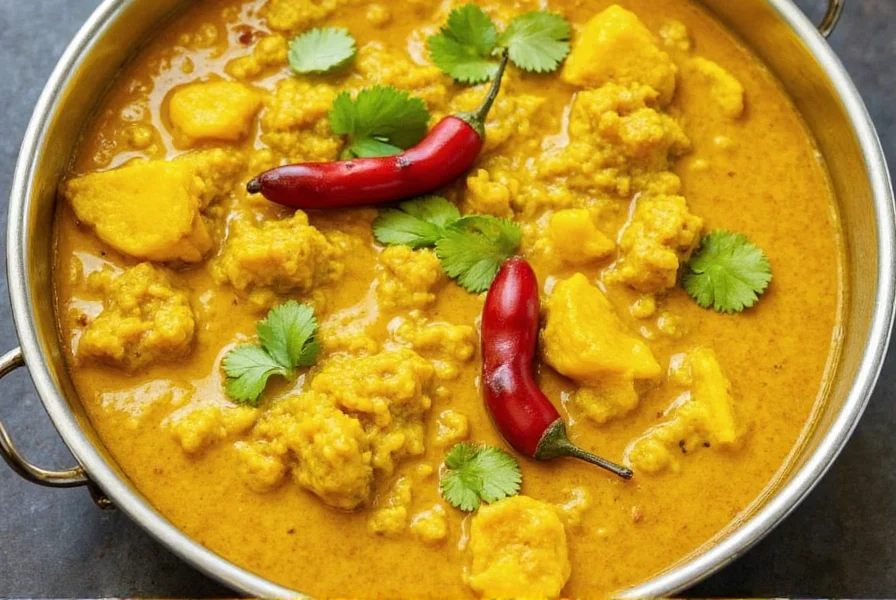Table of Contents
What Is Madras Curry?
Madras curry is a vibrant, spicy spice blend originating from Chennai (formerly Madras), India. It's a key component in South Indian cuisine, known for its bold heat and aromatic flavor profile. This blend typically contains turmeric, coriander, cumin, chili powder, and sometimes garlic or ginger, with the defining characteristic being its bright yellow-orange color and smoky heat. Unlike generic "curry powder," Madras curry specifically refers to a hotter, more robust blend developed in Tamil Nadu and exported globally under this name.
Madras Curry vs. Other Curries
| Curry Type | Flavor Profile | Heat Level | Common Uses |
|---|---|---|---|
| Madras Curry | Spicy, smoky, and aromatic | Medium to high | Stews, soups, rice dishes, and meats |
| Korma Curry | Mild, creamy, and nutty | Low to medium | Vegetables, chicken, and lamb |
| Garam Masala | Warm, earthy, and complex | Low to medium | Finishing spice for curries, stews, and meats |
How to Use Madras Curry in Cooking
Madras curry is incredibly versatile. Whether you're making a classic Indian dish or experimenting with new recipes, this spice blend can elevate your cooking. Here are some popular ways to use it:
- Curries: Add a teaspoon or two to your favorite chicken, vegetable, or lentil curry for an extra kick of flavor and color.
- Marinades: Mix it with yogurt or oil to create a flavorful marinade for meats like chicken or lamb.
- Stews and Soups: Stir it into vegetable or meat-based stews for a deeper, more complex taste.
- Rice Dishes: Sprinkle it over basmati rice or use it to cook rice for a fragrant, spiced side dish.
- Snacks and Sides: Use it to season roasted vegetables, chickpeas, or even popcorn for a spicy twist.
Buying Guide for Madras Curry
When shopping for authentic Madras curry, prioritize these factors:
- Ingredients: Ensure the blend contains real spices like turmeric, coriander, cumin, and chili powder. Avoid products with artificial additives or fillers.
- Origin: Look for brands specifying Indian origin or traditional Tamil Nadu production for authenticity.
- Quality: Choose reputable spice companies known for consistent quality. Organic options are ideal for health-conscious buyers.
Practical Tips for Using Madras Curry
- Start Small: Madras curry is potent—begin with 1/2 teaspoon per serving and adjust to taste.
- Toast for Depth: Dry-toast the powder in a pan for 30 seconds before adding to dishes to enhance aroma.
- Store Properly: Keep in an airtight container away from light and moisture to maintain freshness for up to 1 year.
- Pair Wisely: Combine with complementary spices like cumin, coriander, or mustard seeds for layered flavors.
Frequently Asked Questions About Madras Curry
What exactly is Madras curry?
Madras curry is a spice blend originating from Chennai (formerly Madras), India. It's not a single spice but a carefully balanced mix of various spices including turmeric, coriander, cumin, chili powder, and sometimes garlic or ginger. The defining characteristics of Madras curry are its vibrant yellow-orange color and its rich, slightly smoky heat.
Is Madras curry the same as regular curry powder?
No, Madras curry is a specific type of curry powder that's generally spicier and more robust than standard curry powder. While "curry powder" is a broad term that can vary significantly by brand and region, Madras curry specifically refers to a hotter, more aromatic blend that originated in South India.
Why is it called Madras curry?
It's named after the city of Madras (now called Chennai), which is the capital of the Indian state of Tamil Nadu. The blend became popular in this region and was subsequently exported worldwide, carrying the city's name with it.
How spicy is Madras curry compared to other curry blends?
Madras curry is generally considered medium to high on the heat scale compared to other curry blends. It contains more chili powder than milder blends like Korma, giving it a noticeable kick. However, the exact heat level can vary between brands and recipes.
What's the difference between Madras curry and Garam Masala?
While both are Indian spice blends, they're quite different. Madras curry is typically used as the base for curry dishes and has a more pronounced heat. Garam Masala is usually added at the end of cooking and has a warmer, earthier flavor profile with less heat. Madras curry contains more turmeric (giving it that yellow color), while Garam Masala often includes more cinnamon, cardamom, and cloves.
Can I make Madras curry powder at home?
Yes, you can easily make Madras curry powder at home. A basic recipe includes: 2 tablespoons coriander seeds, 1 tablespoon cumin seeds, 1 teaspoon fenugreek seeds, 1 teaspoon mustard seeds, 1 teaspoon turmeric, 1-2 teaspoons chili powder (depending on your heat preference), 1/2 teaspoon black pepper, and 1/4 teaspoon asafoetida (optional). Toast the whole spices, then grind them with the powdered spices for a fresh, aromatic blend.
Conclusion
Madras curry is more than just a spice—it's a doorway to a world of rich, bold flavors and cultural heritage. Whether you're a seasoned chef or a curious home cook, this spice blend offers endless possibilities for creativity and culinary exploration. By understanding its origins, flavor profile, and best practices for use, you can confidently incorporate it into your cooking and bring a touch of Indian cuisine to every meal.











 浙公网安备
33010002000092号
浙公网安备
33010002000092号 浙B2-20120091-4
浙B2-20120091-4